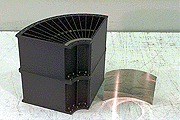X-ray Mirror
Development of the Highest Energy X-ray Mirror
A new type of X-ray mirror that allows images to be made from higher energy radiation than ever before has recently completed testing at NASA's Goddard Space Flight Center, Greenbelt, MD. Previously, these high energy (or "hard") X-rays could only be detected using large detectors, which do not form an image. The imaging technique offers great improvements in sensitivity and resolution, and will allow the direct observation of important physical processes in such unusual celestial objects as neutron stars and black holes. Often, these objects are associated with the emission or generation of high energy X-rays.
 Credit: NASA |
The mirrors, which utilize a new multilayer coating over foil reflectors, were found to successfully focus an image over an X-ray energy range of up to 35 kiloelectron volts (keV) during tests at Goddard from Aug. 12-20, 1997. An electron volt (eV) is a measure of the energy carried by a particle of light, called a photon. Photons at visible light energies carry about 2 - 3 eV, so the new mirrors can reflect light that is about 15,000 times more energetic than visible light. The mirrors are the product of a collaboration between two teams of researchers, one led by Dr. Peter Serlemitsos of Goddard and the other by Dr. Koujon Yamashita at the University of Nagoya, Japan.
The ability to provide true imaging will offer significant improvements in sensitivity and resolution over current instruments in the hard X-ray band. Focusing the X-rays from a distant source onto a tiny spot makes the most of a weak signal, since it is not overwhelmed by background noise from a much larger area. The signal-to-noise ratio is expected to be hundreds of times better, resulting in the ability to detect and study distant sources from which only a small amount of radiation reaches the Earth's vicinity.
Scientists have long been aware of the advantages of X-ray imagers, but they have been difficult to build. X-rays have enough energy to pass right through an ordinary mirror instead of being reflected off it. However, lower-energy or "soft" X-rays can be reflected if the mirror is stood on edge so that the incoming radiation just grazes the surface. The sensitivity of a "grazing-incidence" mirror can be increased by nesting several such surfaces inside each other like a set of measuring cups. Still, hard X-rays above about 10 keV have too much energy to be detected by such a system without the addition of the new multilayer coating. The new coating technology increases the energy range that the mirrors can reflect to approximately 40 keV.
Hard X-rays are given off as thermal energy from the very hottest objects, such as the region around black holes and the jets emitted from active galactic nuclei. Non-thermal emission sources of hard X-rays include the acceleration of particles in very high magnetic fields, such as those of neutron stars. Telescopes incorporating the new mirrors will also be able to observe changes in X-ray emission during the repeating cycles of pulsars, as well as evidence of the production of heavy elements in supernova explosions.
It is expected that the new mirrors will be used on the International Focusing Optics Collaboration for micro-Crab Sensitivity (InFOCuS), a balloon-borne instrument proposed for launch in 1999. The micro-Crab, a unit used in X-ray astronomy, is equivalent to one millionth of the X-ray emission from the much-studied Crab Nebula. The achievement also represents an enabling technology for the proposed Constellation-X mission.

